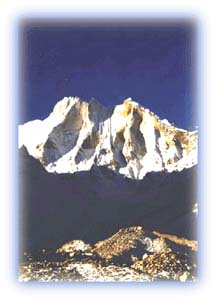Garhwal himalayas
General info
· Uttarakhand
· Eastern Garhwal
· Route to Badrinath
· Haridwar
· Rishikesh
· Devaparayag
· Srinagar
· Rudraprayag
· Chamoli
· Joshimath
· Badrinath
· Mana and Niti
· Valley of Flowers
· Hemkund Sahib
· Route to Kedarnath
· Nanda Devi Sanctuary
· Nanda Devi
· Inner Sanctuary
· Outer Sanctuary
· Western Garhwal
Other Places of Interest
· Uttarkashi
People
· Jaunsaries
· Jadhs
· Marchas
· Bhotias
Religion
· Gods and Goddesses
Flora and Fauna
· Wildlife

![]()
|
Present-day scenario Imagine the fascination of crossing the fearsome Rishi gorge -- where one slip could mean a fall down thousands of feet down to the bottom of the gorge -- to finally emerge into the peaceful valley of the upper Rishi Ganga. The peak of the Nanda Devi -- the goddess herself -- presiding over the panorama of fantastic beauty and piece. When Shipton and Tilman first entered the region, there were herds of bharal, totally unafraid at the approach of man. |
 |
| Meru-North (6,450m). The Meru Massif rises above the upper parts of the Bhrigupanth, Meru, and Kirti valleys. From the East, Meru looks like a long jagged ridge falling down with 800-1200 m high,vertical slab walls. The ridge contains a number of peaks, the most eminent of them being Meru North (6450m) and Meru South (6660m). Credit: Hugo Velthuijsen |
Unfortunately the love of mountain beauty was short-lived. Soon after the first forays into the area, there came a large succession of army-style mountain expeditions that left in their wake piles of junk and garbage on the mountain slopes.
According to news reports, Nanda Devi experienced from 1964 onwards the indignity of several hush-hush expeditions to place a nuclear spying device on her summit! Ten years later, the Sanctuary was thrown open to mountaineers. The resulting stampede of young Western climbers eager to make their marks on the mountaineering record books led to an environmental disaster.
Owing to the short season, pressure tactics were applied to get pack goats to carry the equipment of the mountaineers. Forests were hacked to build bridges and provide fodder for the animals. Fragile juniper slopes above the tree-line were deliberately burnt to provide charcoal for the porters accompanying the mountaineering expeditions, whom the foreign expeditions had neglected to supply with warm clothes. The Indian Mountaineering Association (IMF) was itself so busy collecting peak fees from the foreign mountaineers that it neglected the area it had been created to protect. Instead of closing the sanctuary to protect its unique status, the IMF simply hiked up the fees to climb the peaks in the region.
In a few decades the Sanctuary, at its worst, resembled a combination of a garbage dump and a badly maintained public toilet, the animal life reduced to intruding man, the juniper and undergrowth mercilessly destroyed to provide firewood. Ultimately, the Sanctuary was declared a National Park. This disallows anyone to enter it. Only in the last few years, some scientific expeditions have ventured into the area to analyze the situation and also to organize clean-up operations.
All rights reserved